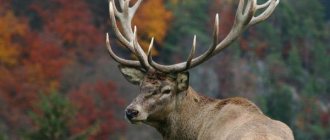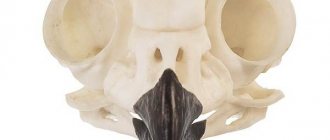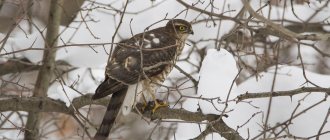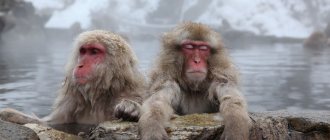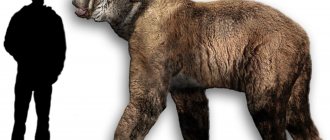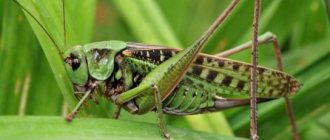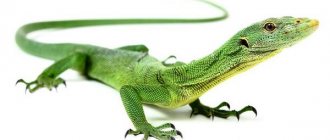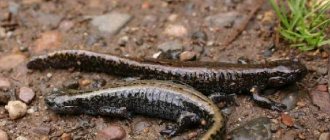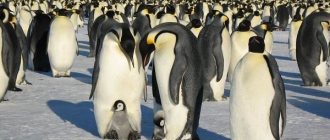Bears are very strong and agile animals, although they seem clumsy. They are good tree climbers, skilled swimmers, fast runners, and can stand and walk short distances on their hind legs. Almost all bears have a powerful body, strong paws with large claws, and a short tail.
Different species of bears live in very different environments. They thrive in the steppes and highlands, in forests and in arctic ice. Today there are 8 main species of this family with many subspecies.
Description, structure, characteristics
Currently, the bear is the largest land predator on our planet; having appeared on Earth about 6 million years ago, it immediately became the personification of power and strength.
Depending on the species, the body length of a bear can range from 1.2 to 3 meters, with a weight from 40 kg to a ton. The bear's body itself is large, stocky, with a thick, short neck and a large head.
The bear's powerful jaws make it easy and convenient to gnaw both plant and animal food. The bear's paws are short and slightly curved; for this reason, bears walk with a slight sway and rest on the entire foot. It is because of this anatomical feature of the structure of bear paws that the nickname “clubfoot” has been attached to them since ancient times. Although, despite their “clubfoot” and apparent clumsiness, bears are very fast and agile - the speed of a bear chasing prey or in moments of danger can reach up to 50 km per hour.
And bears are not only excellent runners, but also no less good swimmers, they are excellent swimmers, and polar bears even have special membranes between their paws, all for ease of swimming.
Bears can also climb trees. All these features make meeting a clubfoot in the forest very undesirable and dangerous, because if something happens, you can’t hide from it either in a tree or in the water.
A bear’s hearing, however, like its vision, is not its strong point (it’s not for nothing that there is even a saying about a person deprived of an ear for music - “a bear stepped on his ear”). But these shortcomings are more than compensated for by the excellent sense of smell that all bears have. It is thanks to smells that bears navigate the surrounding space and receive the necessary information about what is happening around them.
All bears are covered with thick fur. The color of a bear's fur depends on its species, and sometimes determines its name: brown bear, polar bear. Interesting fact: bears with dark fur, like people, turn gray in old age, and their fur turns from black to gray. It is also interesting that in the zoo in Leipzig there is a bear without hair, more precisely, it is a bear named Dolores, as scientists believe, she lost her hair due to some rare genetic disease. But something like this in the bear kingdom is truly an exceptional phenomenon.
Baribal
He is also an excellent tree climber, but now lives in North America. The structure of the animal is similar to an ordinary brown bear, however, it is colored black and has a narrowed muzzle. The baribal is also smaller than most brown clubfoot. The maximum weight of a black bear is 150 kilograms. The body length of the baribal does not exceed 180 centimeters.
Tenacious and strong claws, as well as elongated legs, help the baribal to climb trees. However, they do not help the species survive. The number of the species is declining due to the development of its habitat by humans and the sharing of space with grizzly bears. According to the latest data, there are less than 200 thousand baribals left.
When choosing places to live, baribals avoid altitudes less than 900 meters above sea level.
The baribal's fur is smooth, lightened on the face and, sometimes, on the chest. On large and widely spaced ears the cover is shortened.
Some baribal specimens are brown. These are young bears. Predators that have reached sexual maturity are colored black.
Nutrition
Bears are omnivores who love to feast on various forest game (hares,
deer, roe deer, elk, all can become prey for a bear), as well as juicy berries and fruits. They will not refuse fish either; by the way, some bears are excellent fishermen, skillfully catching fish in rivers and lakes. Just like a real sweet tooth, bears love honey, which sometimes makes forest bees very nervous (the favorite children's cartoon about Winnie the Pooh and his trip for honey has a very real basis).
But also the diet of a bear depends on its species, for example, a good-natured panda is a vegetarian bear, as it eats only bamboo shoots, a Himalayan bear eats with pleasure
frogs, insects and mollusks, but the polar bear is a true predator that feeds exclusively on meat; it cannot be lured by plant foods.
Malayan bear
Otherwise called biruang. Among bears, he is a dwarf, weighs no more than 65 kilos, and is maximum 140 centimeters in length.
The color of the biruang is dark brown. The muzzle is highlighted red. The same paint is present on the chest, where the horseshoe-shaped mark is located.
In addition to its size and color, the biruang is distinguished from other bears by its extended, clawed paws and the almost complete absence of ears.
Geographically, the Malayan bear belongs to India and Indonesia, which also includes Malaysia.
The lifestyle of the Malayan bear is nocturnal. During the day, the predator sleeps on the branches. Because he climbs trees very well. On palm trees, for example, the clubfoot looks for coconuts. The bear chews them, which indicates the strength of the animal’s jaws.
From animal food, the biruang accepts insects and small rodents and reptiles. However, even tigers are afraid of bears. Biruangs are aggressive, more powerful than they seem. Bears do not want to attack tigers, but they are capable of defending themselves.
Lifestyle
All types of bears, with the exception of the white one, lead a sedentary lifestyle. They try to live either alone or in small families (a mother bear with cubs). Each bear has its own territory in the forest, where it lives and hunts. In winter, bears go into hibernation, which is one of the characteristic features of these animals.
Himalayan bear
Similar to the common brown, but slimmer and with a slightly elongated muzzle. On the neck, the hair is elongated and raised, reminiscent of a lion's mane. The Himalayan bear is also dangerous, like a lion. The predator got into the habit of attacking livestock. This is associated with the extermination of the species.
The color of the Himalayan bear is jet black. There is an orangeish tint on the chest. Individuals without this spot are considered a separate subspecies.
The length of representatives of the Himalayan species does not exceed 170 centimeters. The weight is 140 kilograms. Bears gain weight not only by eating meat. Himalayan individuals also love honey, nuts, and roots.
So it became clear how many types of bears there are . If we take into account the conditionally extinct Syrian, we get 8. False bears can be added to the list. They are not related to the true ones, but are also called. Just remember the koala. It is called the tree bear. There is also a bamboo one - panda.
Hibernation
A bear's winter hibernation can last up to 200 days. In preparation for it, bears actively stock up on fat in the fall, and this is critically important for the bear. Those bears that have not managed to gain sufficient fat reserves cannot hibernate and, as a result, turn into connecting rod bears (they also become connecting rod bears due to the bear awakening too early after hibernation). Connecting bears are very dangerous animals (including for humans), attacking everything they come across in the forest. Usually connecting rod bears die from hunger, cold, or a hunter's bullet.
As for the state of ordinary bears hibernating in their secluded den, what is happening to them is somewhat reminiscent of suspended animation - the clubfoot’s pulse during hibernation decreases from the usual 55 beats per minute to 9 beats per minute. The level of metabolism (metabolism) in the bear's body decreases by 53%. At this time, bears, of course, do not eat, drink, or defecate; all their life processes seem to be paused. The exact mechanism of how bears actually hibernate is to this day the subject of scientific research by zoologists.
Types, photos and names
In the bear family, zoologists have identified 8 main species of bears, which in turn are divided into many subspecies, and we will dwell on them below.
Brown bear
It is also known as the common bear and is the most typical representative of this species. It has thick brown fur, which is why it got the name brown. It lives over a wide geographical range, in the forests of Eurasia, North America, in our country brown bears are found in the Carpathian forests, although in our time it is very rare to see them (but for unlucky tourists this is for the better). Many brown bears are found in the Siberian taiga, the forests of Scandinavia, Canada and some northern US states (for example, Montana).
Polar bear
He is also a polar bear - he is the largest bear in the world, the body length of a polar bear is 3 meters, with a mass of just over 1 ton. These bears are perfectly adapted for life in the northern Arctic latitudes, from their white fur, with which they can be invisible in the snow, to the special structure of their paws, which have membranes for ease of swimming (polar bears swim a lot between ice floes). Just as we wrote above, it is polar bears that are one hundred percent predators, although, strangely enough, the disposition of polar bears is more good-natured than that of their brown relatives. Polar bears live in the polar regions of the northern hemisphere. And by the way, on our website there is a separate article about
polar bear, follow the link.
Baribal
He's a black bear. In many ways it is similar to a brown bear, but differs from it in its smaller size and characteristic black coat color. The length of a black bear does not exceed 2 meters. Baribals live in North America: from the vastness of Alaska to hot Mexico.
Malayan bear
He is also the biruang, is the smallest bear in the world, well, how small, the biruang still reaches 1.5 meters in length. It differs from other bears in its disproportionately large paws with huge claws. The body of the Malayan bear is covered with black and brown fur, and its chest is decorated with a white and red spot. The Malayan bear lives in southern China, Thailand and Indonesia.
Himalayan bear
He's a white-breasted bear. It is far from the largest representative of the bear family; its size is half that of a brown bear - its body length is 1.5-1.7 m. It also has a white or yellowish spot on its chest. The Himalayan bear lives in the mountainous regions of the Himalayas, in Afghanistan, Tibet, Korea, Vietnam, and China.
Spectacled bear
Named so due to its unusual coloring on the face, which has white and yellow rings. It is of medium size - the body length of the spectacled bear is 1.5-1.8 m. It lives in South America, in countries such as Colombia, Bolivia, Peru, Ecuador, Panama.
Sloth bear
This bear has an elongated muzzle and is of medium size (body length is up to 1.8 m). The sponge's fur is black or brown, and closer to the head it forms something like a shaggy mane. He also has a light spot on his chest. These bears live in India, some areas of Pakistan, Bhutan, Bangladesh and Nepal.
Panda
He's a bamboo bear. The panda is the friendliest and most peaceful among the bears, as evidenced even by their diet; pandas feed exclusively on plant foods, mainly bamboo shoots. The panda's characteristic appearance - a white head, body, and black paws - distinguishes it from other types of bears. Pandas live in the mountainous regions of China and Tibet.
Spectacled bear
It differs from others in having a long tail for a bear. It is equal to 10 centimeters. The name of the species is associated with color. There are light spots around the eyes, reminiscent of the scent of glasses. There is dark fur inside them. The bear appears to be wearing sunglasses.
Spectacled bears weigh a maximum of 140 kilograms and do not exceed 170 centimeters in length. The entire body is covered with dense hair. It is black-brown or completely black.
The spectacled bear lives in South America. The biology of the species is poorly studied, since clubfoot species are awake at night. At this time, the animal eats, breaking palm branches, collecting berries, fruits, and herbs. The spectacled bear almost does not engage in predation. The protein diet is limited to insects. In order to remove them from hiding, the clubfoot uses an elongated tongue.
The spectacled bear obtains many fruits from trees, excellent at climbing trunks. Developed, tenacious claws help.
Reproduction
Despite the fact that bears are monogamous animals, their pairings are usually short-lived and break up after a couple of years. The mating season for bears can occur at different times (depending on the species), but what is interesting is that mother bears always give birth to their cubs in the winter, right during hibernation and leave the den with cubs. The pregnancy of a female bear, depending on the species, lasts from 180 to 250 days. From 1 to 4 cubs are usually born at a time.
Little bear cubs are born without fur, without teeth and with closed eyes. At first, they are completely dependent on their mother, feeding on her milk, then they begin to quickly gain weight and grow hair until they turn into full-fledged adult bears.
They are quite hardy
Bears typically move relatively slowly, with a shuffling, plantigrade gait. But despite their clumsiness, they are able to move surprisingly quickly even over obstacles that could seriously impede the movement of a person or horse. If necessary, they can walk on their hind legs.
Polar bears are excellent swimmers, and Malayan bears are strong arboreal climbers. Most bears move across a very large range to satisfy their metabolic needs. Female polar bears migrate from the pack ice in late autumn to give birth to their cubs in dens.
Keeping in a zoo
Nowadays, the only places where you can observe bears with your own eyes are zoos, where they are kept in large spacious enclosures designed to recreate natural conditions as much as possible. In addition to trees and stones, the enclosure must have a small pool in which the bears will swim from time to time. The bear's food should also depend on the season and include those products that are available to the predator in natural conditions.
Menu for the predator
Bears eat absolutely everything as food, it can be berries and mushrooms, nuts and various roots, all kinds of meat and fish; ants, bee larvae and honey can serve as a delicacy for animals; there are also vegans among bears, these are pandas and koalas.
Among all the diversity of bears, the pure predators are again polar bears, whose diet includes only fish and meat.
Interesting Facts
Video
And in conclusion, an interesting documentary about brown bears.
Author: Pavel Chaika, editor-in-chief of Poznavaika magazine
When writing the article, I tried to make it as interesting, useful and high-quality as possible. I would be grateful for any feedback and constructive criticism in the form of comments on the article. You can also write your wish/question/suggestion to my email [email protected] or Facebook, with respect, the author.
Author page

